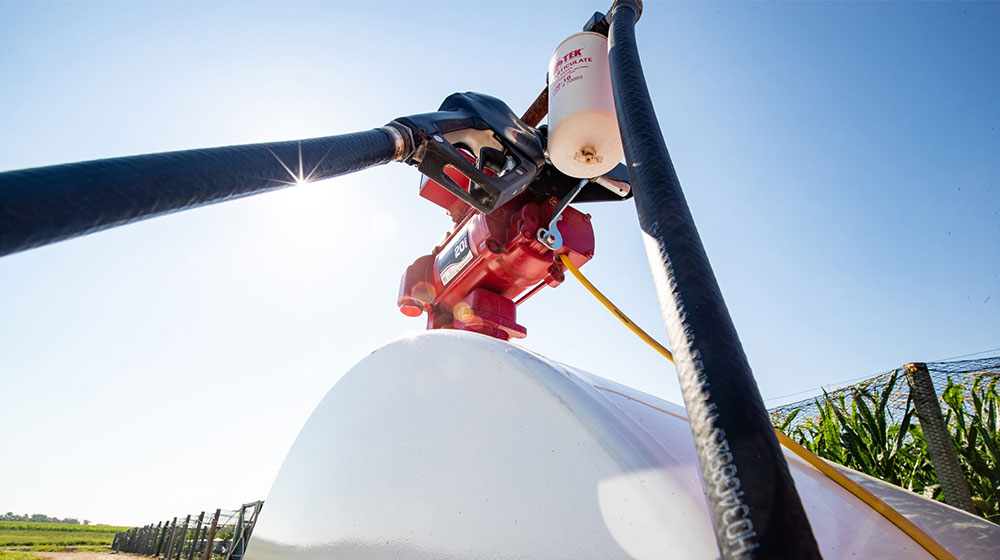During the busiest seasons, you may be focused on the many planting or harvest tasks on your list, but equipment experts advise keeping two key questions top of mind to keep equipment running at peak efficiency:
- “What’s in my fuel tank?”
- “When was the last time I checked?”
With temperatures swinging high and low and more moisture in the air, spring and fall are some of the most critical times of the year to monitor and maintain bulk fuel tanks.
“The conditions are primed to wreak havoc on your tanks and allow water to seep in,” says Andrew Manchester, energy equipment account manager at CHS.
“Water is the No. 1 enemy for your fuel. Once water enters your tank, it can create algae, rust and other contaminates that degrade your tank and fuel quality.”
One step you can take to help combat water and contaminants is using a high-performance premium diesel fuel with a two-phase total water management system like Cenex® Ruby Fieldmaster®, which efficiently separates the majority of the water from your fuel, allowing it to settle quickly at the bottom of your fuel storage tank for easy drainage and removal. Then, any remaining negligible water is encapsulated for safe passage through your equipment’s combustion chamber.
But Manchester also advises building an organized action plan for tank maintenance.
“There’s no substitute for consistent tank maintenance,” he says. “You can put the best fuel in your tank, but if that tank’s been compromised, it won’t matter what kind of fuel you’re using. It’s already been compromised.”
Use the following tips can help to build a tank maintenance routine that protects your fuel and equipment to keep your operation running smoothly.
Mark the seasons
Building time into your schedule for seasonal tank maintenance can prevent potential contamination and help extend the life of tanks and equipment.
Manchester notes maintenance before the first freeze and immediately after the first thaw are critical times for maintenance.
“If water gets in your tank during the winter and freezes there, algae buildup can start to grow as soon as the ice begins to melt. Be prepared to act fast as soon as the temperatures change.”
Pay attention to filters
If you find you’re changing fuel filters more often, Manchester notes the issue likely isn’t the filter itself, but a sign of a larger problem.
“If you’re going through filters quickly, that’s a sign you could have water or contamination in the fuel and it’s time to take a look in your tank.”
Inspect before you fill
Before receiving fuel deliveries, Manchester recommends inspecting your tank to ensure it won’t pose risks to incoming fuel.
Assess the tank’s fittings, openings, vent, pipe dope and caulking to ensure no repairs are needed. If repairs are needed, skip the homemade or DIY quick fixes.
“Whether it’s a silicone-based caulk or a gallon of algae killer, those homemade solutions might look like they’re holding in the short term, but they’re not effective long-term and they often compound the problem, leaving you with more risk.”
Rethink your tank setting
Is your fuel tank set on a perfectly even, level surface?
“Ideally, your tank will be set at a 1 or 2% incline or decline,” says Manchester. “You want enough angle so water can settle on one end of the tank, making it easier to drain.”
Manchester also advises setting the tank to tilt away from its filling point, and to avoid using biodegradable materials for the base, including wood.
“Once wood ages and breaks down, your tank will start to shift, which could cause issues.”
Invest in basic tools
Manchester advises keeping a sufficient stock of simple, easy-to-use tools like water-finding paste, gauge sticks and fuel sample kits on-hand at all times.
“I recommend using water-finding paste and taking a fuel sample each time your tank is opened. They’re fast, easy ways to confirm what’s going on inside your tank so you can catch an issue early. If you find water in the tank, contact your co-op or fuel provider for assistance.”
Document your findings
Each time you take a fuel sample, Manchester recommends keeping a log to document and track the results.
Fuel sample records, along with consistent tank maintenance, can help pinpoint the cause of an issue if tank problems arise.
Learn more
To learn more about tank maintenance and fuel sample kits, contact your local Cenex dealer.




